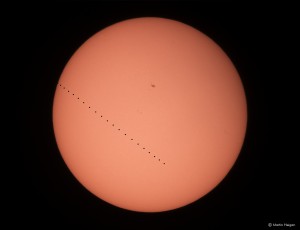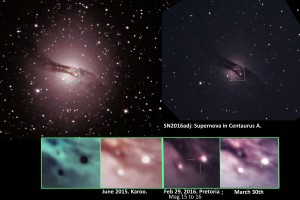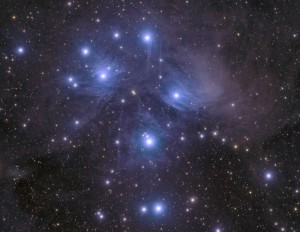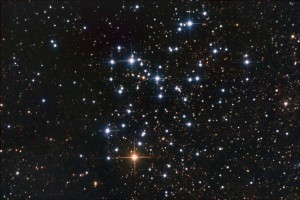June 2016: Mercury's transit of the Sun, on 9 May 2016 by Martin Heigan
On 9 May 2016, Mercury passed in front of the Sun, where it was visible from Earth as a tiny black disc, moving across the Solar surface over the course of a few hours. Mercury orbits around the Sun every 88 days, but because it orbits in a plane 7 degrees tilted from Earth’s orbit, it normally appears to skip either above or below the Sun. Transits like this one, where it lines up with the Sun from our point of view, are quite rare: Last time it happened was in 2006, and it won’t happen again until 2019.
This is a composited time-lapse sequence of Mercury’s transit path, photographed between 13:05 – 17:25 from Johannesburg. It was a challenge to image in partly cloudy conditions. At S 26° Latitude, the last bit of the transit was not visible due to the Autumn Sun setting before the transit was complete.
May 2016: Amateur Spectrography by Percy Jacobs
Have you ever heard an astronomer confidently list the ingredients of some gas cloud or star that they are showing you through their telescope and wondered “But it’s so far away! How do you know?”
The answer is spectroscopy. When a rarefied gas is energised, it begins to glow. If we split the light of that glow with a prism, we find that light produced in this way is made up of only a few very specific colours, and by studying exactly which colours are visible, we can identify the molecules making up the gas.
Eta Carina is a group of at least two massive stars nearing the end of their lives, swelling and shrinking, and shedding their own outer layers. This process has surrounded the group with a vast cloud of gases, and the exposed inner layers light them up in hot ultraviolet radiation, causing them to glow with the colours of their ingredients.
This image is a composite of a Hubble Space Telescope image of Eta Carina, and a spectrum captured by amateur astronomer Percy Jacobs. The different peaks on the spectrum reveal the characteristic colours of different molecules making up the gas cloud around Eta Carina. He has marked out the peaks, and labelled the ones he has been able to identify.
For more information, see how NASA created their own similar image.
April 2016: Type II supernova in NGC 5128 by Johan Moolman
On 8 February 2016, Peter Marples and Greg Bock reported their discovery of a possible supernova in NGC 5128, the bright active galaxy that’s such a popular sight in the Southern skies. The discovery was confirmed, and identified as a Type II supernova.
Johan Moolman managed to capture an image of it shortly afterwards, and has captured several images since, which he compared to earlier images of the same galaxy that he’d captured the previous year, before the supernova exploded.
This month’s image is a composite of those pictures, showing its progression over time.
February 2016: M45 by Andre Potgieter
The Pleiades is one of the most famous open clusters in our skies. Visible from anywhere on Earth to the naked eye, almost all cultures on Earth have incorporated it into their mythology and folklore. It’s appearance was widely used to mark the beginning of a season, for agricultural and navigational purposes and it has famously been used as a test for vision: Most people with good eyes should be able to make out at least six stars, although some can see eight or more without using binoculars or a telescope!
This is a particularly young cluster, at under 150 million years, so a lot of the dust and gas from which it formed is still present, and can be seen reflecting the light of the stars in this image. It is approximately 444 light years away and contains over a thousand stars (not counting individual members of binary pairs). The majority of these stars are hot and blue, although it also contains a significant number of brown dwarfs.
January 2016: M6 - open cluster by Andre Potgieter
The Butterfly Cluster, number six on Charles Messier’s famous list of deep sky objects, is an open cluster near the tail of Scorpius. It is about 100 million years old, contains over 330 suns (mostly hot blue-white stars) and is a little under 1600 light years away.
If emission nebulae like the great nebula in Orion are stellar nurseries, then open clusters are stellar kindergartens: The stars have been shining for long enough that their radiation and stellar winds have blown away most of the gas and dust that birthed them, but they still live at home with their siblings. The individual stars of the cluster, which are only loosely gravitationally bound to each other, will gradually disperse until the cluster is no more.
October 2015: A sequence of images showing the eclipse from start to finish by Carol Botha
On September 28th, The Moon passed through the Earth’s shadow while at perigee, an event which trended on social media as #SuperBloodMoon. While serious astronomers don’t think much of such misleading names, this particular eclipse was a particularly dark one. Partially this was because the Moon was at its closest point to Earth, where the shadow is wider and deeper, and partly because of large amounts of dust and aerosols in the Earth’s atmosphere at the time of the eclipse which reduced the amount of light refracted into the shadow.
This sequence of images was captured by Carol Botha using a Canon 5D MK II, fitted with a 400mm lens,






